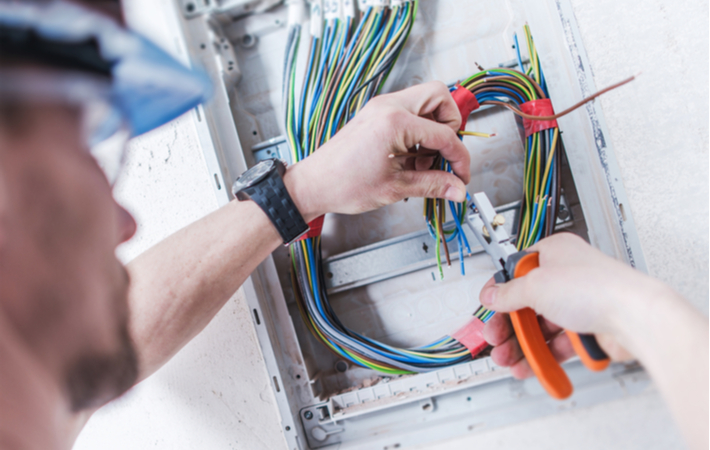So you’ve heard of fiber internet, but how do you actually get it to your house or business? There are some key differences between traditional internet fiber internet, both in their speed and in their installation.
Types of Fiber Internet Connections
There are 3 main types of fiber internet connections that bring fiber internet to your home or business:
- FTTP: fiber to the premises
- FTTB: fiber to the building
- FTTN: fiber to the node
Before discussing how your fiber internet is installed, you first need to know what kind of connection you have.
Fiber to the Premises (FTTP)
Fiber to the premises is exactly what you think it is; fiber optic internet cables that are run directly to your home or business. Of all the options, it is the only one that provides true fiber internet as other installation methods rely on a combination of fiber and cable internet.
While it is the most direct option, it is also the most expensive to build initially. If you don’t already have FTTP setup, FTTB or FTTN may be available in your area.
Fiber to the Building (FTTB)
Fiber to the building is fiber optic cables that run to a building, but not to individual users within the building. Common examples are schools, hotels, apartments, and office buildings. The fiber connects to a hub within the building and is then distributed throughout the building via copper cables.
Fiber to the Node (FTTN)
Fiber to the node works similarly to FTTB, but instead of the fiber optic cables running to individual buildings, they connect to a central hub. It’s also known as fiber to the neighbourhood as often a neighbourhood will contain one hub for fiber optic users in the area. In most cases, the furthest user is no more than 1,000 feet from the node.
From the node or hub, the internet is then brought to individual homes or businesses through copper cables. In some areas, this is the most cost-effective option as existing cable internet infrastructure can be used to transmit the internet from the node to individual users.
For smaller communities or communities in remote areas, FTTN can be combined with wi-fi to provide users with fiber internet. The fiber is built to a central hub, then distributed to the residents in the area through wifi. No infrastructure to individual homes, including cable internet, needs to be built, making it a cost-effective and faster internet alternative for small communities.
Getting the Internet from the Cables to You

Depending on which type of connection you have, the final steps in your internet installation will vary slightly. For FTTP, you will need equipment specialized for fiber internet, whereas for FTTB and FTTN, you can use existing cable internet equipment for the most part.
Installation Process for FTTP
Because the fiber optic cables run directly to your house with FTTP, you will require specialized equipment for fiber optic internet cables. For the most part, the installation will need to be done by a qualified technician. Before installing your fiber internet equipment, make sure you clear space for the technician to work. Also, make sure that if you rent your home or business that you have written consent from your landlord to install the necessary equipment.
The technician will first install an optical network terminal (ONT). The ONT translates the fiber light to a digital signal to connect to your computer or other devices. A traditional cable internet modem won’t work for fiber internet as they translate a different signal type, analog, to digital.
Usually, the ONT will be installed somewhere on the outside of the building or in your garage or basement. If you have existing phone lines, these will need to be replaced via the ONT. Some older phones aren’t compatible with this new technology, so you’ll need to check for compatibility if you have a landline.
Once your ONT is in place, you can connect to the internet directly through an ethernet cable or through a router. A router will take your fiber optic internet and turn it into a wireless or wi-fi signal.
Installation Process for FTTB & FTTN
The installation process for FTTB and FTTN is slightly simpler than FTTP as they largely rely on existing infrastructure and equipment. Assuming your home or business has a cable internet connection, connecting to fiber internet via FTTB or FTTN should be relatively easy and you will likely be able to do it yourself.
You will be able to use your existing modem, which connects to the copper cable internet cables, and then connects to the fiber internet hub in your building or neighbourhood.
The main change is you may need to look into getting a new wireless router if you use wi-fi. Since the speeds of fiber optic internet are much faster than cable internet, your existing router may not be able to handle the increased internet speeds.
Fiber Internet Installation in Your Area
Of course, the installation process relies on there being a fiber optic internet provider in your area. Without a fiber optic internet provider and fiber optic cables, you won’t be able to access fiber internet whether it’s FTTP, FTTB, or FTTN.
Fiber optic internet is becoming more accessible around the world, including right here in Alberta. Tether is working to bring fiber optic internet to rural Alberta and beyond. Depending on your area, we offer FTTP directly to your home or business. For smaller communities, we are working with residents to build effective internet solutions like FTTN combined with wi-fi.
If you want fiber internet for your home or business, let us know that you’re interested here.




